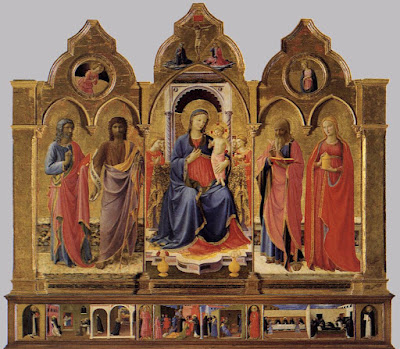Edward Hutton devoted a lengthy chapter to the Pinacoteca Vannucci, Perugia'a picture gallery of Umbrian painting. He especially liked two famous altarpieces taken from their original locations. Looking at these magnificent paintings, it is hard to imagine what ordinary parishioners thought while attending Mass.
Unlike Florence and Siena, Umbria had no Giotto nor Duccio to point out the road she should follow in her art. Umbrian painting, which is not solely centered in Perugia, but which had several centres—Gubbio, Foligno, to name no others—in which it flourished, was really provincial in the true sense of the of the word. And it was from beginning to end the handmaid of the Church, and remained Christian when almost everywhere else art had become pagan. …
The two major single treasures of the gallery are the altarpiece by Fra Angelico and the altarpiece by Piero della Francesca.
 |
| Fra Angelico |
The altarpiece by Fra Angelico is a masterpiece, indeed he never surpassed in feeling and quality some of the smaller figures. The Madonna and Child are enthroned under a baldacchino. On either side are two angels, the foremost two offering baskets of roses. On panels at the sides are various full-length figures of saints: on the left S. Dominic and S. Nicholas, and these are the most exquisite; on the right S. John Baptist and S. Catherine of Alexandria, perhaps the work of an assistant. … Unfortunately, the face of the Virgin has been damaged; otherwise it seems to be in an excellent state, surprisingly bright in colour, and some of the figures of saints are of such beauty that I do not think Angelico ever surpassed them.
The large polyptych by Piero della Francesco is the other great single treasure of the gallery. It is a puzzling work. In the midst of a late Gothic altarpiece, the Madonna and Child enthroned in the centre with four full-length saints, SS. Anthony, John Baptist, Francis and Elisabeth at the sides, much in the form of Fra Angelico’s altarpiece here. Above in a seven-sided pediment, is the Annunciation; below are two rounds with figures of S. Clare and S. Agatha, and below in the predella three scenes: a miracle of S. Anthony, S. Francis receiving the Stigmata and a miracle of S. Elizabeth of Hungary. …
I find the main part of the altarpiece disappointing, as indeed are the predella scenes. But the Annunciation I find one of the most enchanting of Piero’s works. I can never leave it without returning again and again. And then how characteristic it is of the artistic moment dominated by perspective and the theories of Alberti and the practice of Brunelleschi, Laurana, Uccello and Masaccio! What that gracious and formidable angel is announcing to the Madonna, so classical in her monumentality and repose, is not the birth of Christ. but the rebirth, the renaissance, of Antiquity. It may well be that this is a work of Piero’s old age, but if so, your old men shall see visions.
###
Edward Hutton: Assisi and Umbria Revisited, London, 1953. Pp. 179, 184-186.

_(7109657031).jpg)







